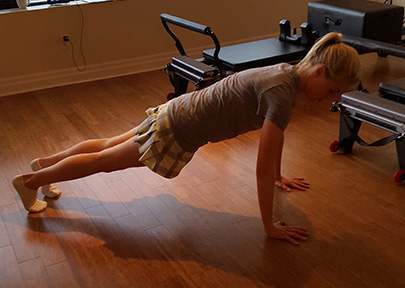Boost your fitness routine with 5 fun training styles

The summer weather has arrived – yeah! Since sunshine makes everything seem more manageable – including being active – now is the perfect time to try something NEW!
When it comes to working out, boredom is the kiss of death. It is hard enough to make yourself train at the best of times – and almost impossible when you feel like yawning!
Plus, if you can do your routine in your sleep, you have most likely hit a training plateau. Meaning, you’re no longer seeing results.
The solution? Surprise your body with something new!
5 ways to pick up your fitness “game”
1. Add some friendly competition
Join a sports team, attend a fitness class that tracks stats (for example OrangeTheory Fitness), and / or get a fitness buddy.
With your buddy, try these “friendly” Fartlek intervals. Partner A sprints toward a random landmark. Partner B has to keep up. Both partners jog for a block, then partner B picks a mailbox or another landmark to sprint toward. Keep alternating sprints for 20 to 40 minutes.
2. Do intervals
Intervals are convenient — you can do them anywhere and on any piece of equipment or even without equipment — AND they are effective. With intervals, you alternate between bouts of high- and low-intensity training. This places a high metabolic demand on the body, burns lots of calories in a short amount of time, produces a high EPOC (post-workout calorie burn), increases mitochondria growth (mitochondria help to burn fat), and helps to improve one’s fitness level. I also find that keeping track of the time and shifting speeds makes my workout go by faster.
Version A. Warm up for five minutes. Do one minute hard, one minute easy, two minutes hard, two minutes moderate, three minutes hard, three minutes moderate, four minutes hard, four minutes moderate, five minutes hard, one minute easy, and five minutes hard. Cool down for five to ten minutes.
Version B. Warm up for five to ten minutes. Then cycle through the following sequence: thirty seconds hard, thirty seconds recovery, sixty seconds hard, sixty seconds recovery, ninety seconds hard, ninety seconds recovery. Repeat three to six times. Cool down for five to ten minutes.
3. Try AMRAP training
AMRAP stands for “as many rounds as possible.” AMRAP is an example of time-based training. With AMRAP, you aim to fit in as many cycles of a circuit as possible within a set time frame. The faster you get through the reps of each exercise, the more times you will complete the entire circuit in the given timeframe. If you are at home, do bodyweight exercises like squats and burpees. If you are at the gym, use the barbell, Bosu or cable machines.
Sample 10-minute AMRAP
Time yourself for 10 minutes — do as many rounds as you can of 10 push-ups, 10 lunges on each leg, 12 bent-over rows and 10 squats. Record how many rounds you get through. Gradually work to increase the number of rounds you can complete in 10 minutes.
A word of caution: only include exercises in your AMRAP that you can do with perfect form. If you can’t do squats well, try lunges. If you can’t do full push-ups, try modified push-ups from your knees. No injuries allowed!
4. Try “Add On Sets”
Pick a “base” and a “rest” exercise. The rest exercise isn’t easy, it just shouldn’t work the muscle groups targeted by the base exercise.
Alternate the base exercise with the rest exercise. Each time you do the base move you add on a version of the same exercise. Confused? Don’t worry – there is an example below. I have used a front plank as my base exercise and a squat hold as my rest exercise, but the world is your fitness oyster. Pick exercises you think your body needs.
Start standing. Bend over to walk your hands forward until your body forms a plank. Hold for five seconds. This is your “base exercise.”
Now, walk your hands backwards and — without standing all the way up — hold a squat. Keep your chest out, back flat, core engaged, knees in line with your middle toes and lower back neutral.
This is your “rest” exercise. Complete a thirty second squat hold in-between each plank. Every time you plank add on a new variation. So, your first plank is a basic plank. Then do a basic plank PLUS a “plank and knee to elbow”. Continue until you have added on five to 10 different plank variations.
5. Try “Minutes”
Pick seven exercises.
Warm-up for five minutes. Then do each of your seven exercises each for a minute. Rest for thirty seconds. Repeat two to four times through.
Make your first exercise a “push” exercise. Push exercises work your chest, shoulders and triceps. Try any variation of the push-up or bench press.
Make your second minute a “pull” exercise. Pull exercises primarily work your back and biceps. Try bent over dumbbell rows, machine rows or pull-ups.
Make your third exercise some version of the squat. Use your own body weight, dumbbells or a barbell. For an extra challenge do squats while standing on a bosu.
Make your fourth exercise your “favourite” type of lunge. Try walking lunges, stationary lunges or bosu lunges. For some variety try a “glider burnout lunge.”
For your two core exercises try any variation of the front plank, side plank or V sit. If you decide to do a core exercise that involves flexing forward — like a crunch — make sure you make your second core exercise an extension exercise like the superman or superwoman.
Do the cardio intervals on any cardio machine. If you’re not at the gym, run up and down your household stairs, do burpies or high knees, skip rope or dance around.
Make sure you cool down and stretch before heading to the shower.
Originally published at FLAMANFITNESS












